
Black-figure pottery painting, also known as the black-figure style or black-figure ceramic, is one of the styles of painting on antique Greek vases. It was especially common between the 7th and 5th centuries BCE, although there are specimens dating as late as the 2nd century BCE. Stylistically it can be distinguished from the preceding orientalizing period and the subsequent red-figure pottery style.
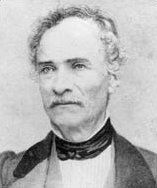
Kyriakos S. Pittakis was a Greek archaeologist. He was the first Greek to serve as Ephor General of Antiquities, the head of the Greek Archaeological Service, in which capacity he carried out the conservation and restoration of several monuments on the Acropolis of Athens. He has been described as a "dominant figure in Greek archaeology for 27 years", and as "one of the most important epigraphers of the nineteenth century".

An aryballos was a small spherical or globular flask with a narrow neck used in Ancient Greece. It was used to contain perfume or oil, and is often depicted in vase paintings being used by athletes during bathing. In these depictions, the vessel is at times attached by a strap to the athlete's wrist, or hung by a strap from a peg on the wall.
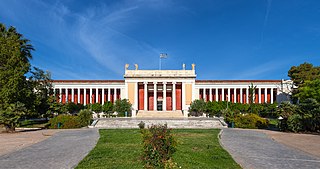
The National Archaeological Museum in Athens houses some of the most important artifacts from a variety of archaeological locations around Greece from prehistory to late antiquity. It is considered one of the greatest museums in the world and contains the richest collection of Greek Antiquity artifacts worldwide. It is situated in the Exarcheia area in central Athens between Epirus Street, Bouboulinas Street and Tositsas Street while its entrance is on the Patission Street adjacent to the historical building of the Athens Polytechnic university.
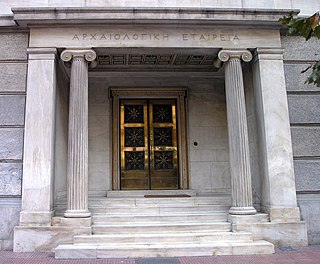
The Archaeological Society of Athens is an independent learned society. Also termed the Greek Archaeological Society, it was founded in 1837 by Konstantinos Bellios, just a few years after the establishment of the modern Greek State, with the aim of encouraging archaeological excavations, maintenance, care and exhibition of antiquities in Greece.

Christos Tsountas was a Greek classical archaeologist. He is considered a pioneer of Greek archaeology and has been called "the first and most eminent Greek prehistorian".
Darrell Arlynn Amyx was an American classical archaeologist. His principal field of study was the archaic pottery of Corinth. Complementing the pioneering work of John Beazley and Humfry Payne, Amyx applied stylistic analysis to the work of previously unnamed and unstudied Corinthian painters, discerning many otherwise forgotten "hands".
Gryton was a Boeotian potter who worked in the first half of the 6th century BC. He is only known by his signature on the sole of a plastic aryballos in the shape of a sandal-clad foot, which is housed in the Museum of Fine Arts in Boston. A catalogue of his works was published by Raubitschek along with works of ancient Boeotian potters. These included the Ring Aryballos, which is part of a collection of Berlin's Staatliche Museen.

Corinth was a city-state (polis) on the Isthmus of Corinth, the narrow stretch of land that joins the Peloponnese to the mainland of Greece, roughly halfway between Athens and Sparta. The modern city of Corinth is located approximately 5 kilometres (3.1 mi) northeast of the ancient ruins. Since 1896, systematic archaeological investigations of the Corinth Excavations by the American School of Classical Studies at Athens have revealed large parts of the ancient city, and recent excavations conducted by the Greek Ministry of Culture have brought to light important new facets of antiquity.
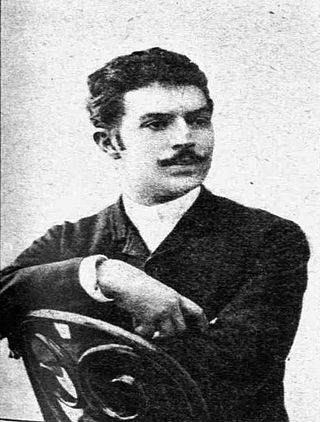
Alexander Philadelpheus was a distinguished Greek archaeologist, historian, painter, writer and philosopher.
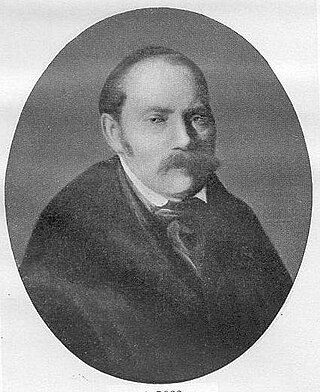
Ludwig Ross was a German classical archaeologist. He is chiefly remembered for the rediscovery and reconstruction of the Temple of Athena Nike in 1835–1836, and for his other excavation and conservation work on the Acropolis of Athens. He was also an important figure in the early years of archaeology in the independent Kingdom of Greece, serving as Ephor General of Antiquities between 1834 and 1836.
The Greek Archaeological Service is a state service, under the auspices of the Greek Ministry of Culture, responsible for the oversight of all archaeological excavations, museums and the country's archaeological heritage in general.

The archaeological site of ancient Kymissala is located about 70 km southwest of Rhodes city, and today falls within the limits of the Municipality of Atavyros, occupying coastal areas of Monolithos and Sianna municipal departments. This is one of the most important archaeological sites in the countryside of Rhodes, as indicated by the extended visible ruins scattered in various places, dating from the Mycenaean period to Late Antiquity. During the Hellenistic period the region, as shown by the maintenance of the ancient place name and inscriptions from the necropolis, belonged to the Demos of Kymissaleis and was subordinated to Kameiros.
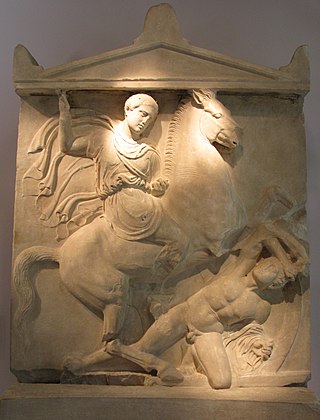
The Grave Stele of Dexileos is the stele of the tomb of an Athenian cavalryman named Dexileos who died in the Corinthian War against Sparta in 394 BC. The stele is attributed to "The Dexileos Sculptor". Its creation can be dated to 394 BC, based on the inscription on its bottom, which provides the dates of birth and death of Dexileos. The stele is made out of an expensive variety of Pentelic marble and is 1.86 metres tall. It includes a high relief sculpture depicting a battle scene with an inscription below it. The stele was discovered in 1863 in the family plot of Dexileos at the Dipylon cemetery in the Kerameikos cemetery of Athens. It was found in situ, but moved during World War II, and is now on display in the Kerameikos Museum in Athens.

Panagiotis Kavvadias or Cawadias was a Greek archaeologist. He was responsible for the excavation of ancient sites in Greece, including Epidaurus in Argolis and the Acropolis of Athens, as well as archaeological discoveries on his native island of Kephallonia. As Ephor General from 1885 until 1909, Kavvadias oversaw the expansion of the Archaeological Service and the introduction of Law 2646 of 1899, which increased the state's powers to address the illegal excavation and smuggling of antiquities.
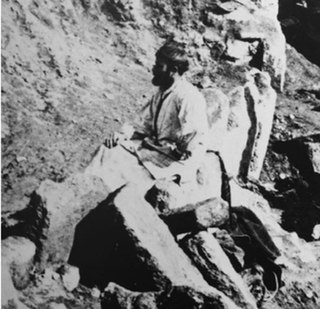
Panagiotis Antoniou Stamatakis was a Greek archaeologist. He is noted particularly for his role in supervising the excavations of Heinrich Schliemann at Mycenae in 1876, and his role in recording and preserving the archaeological remains at the site.
In Greece, ephor is a title given to the head of an archaeological ephorate, or archaeological unit. Ephors are responsible to the Ministry of Culture and Sports.

Panagiotis Efstratiadis or Eustratiades was a Greek archaeologist. He served as Ephor General of Antiquities, the head of the Greek Archaeological Service, between 1864 and 1884, succeeding Kyriakos Pittakis.

Athanasios Sergiou Rhousopoulos was a Greek archaeologist, antiquities dealer and university professor. He has been described as "the most important Greek collector and dealer between the 1860s and 1890s", and as "a key figure in the early days of archaeology in Greece."
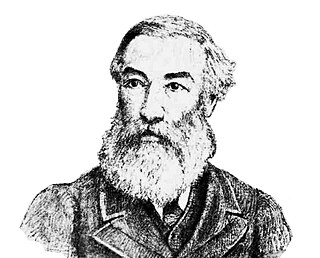
Charles Louis William Merlin was a British banker, diplomat and antiquities trader. He is known for his role in procuring objects, particularly Graeco-Roman antiquities, for the British Museum.


















